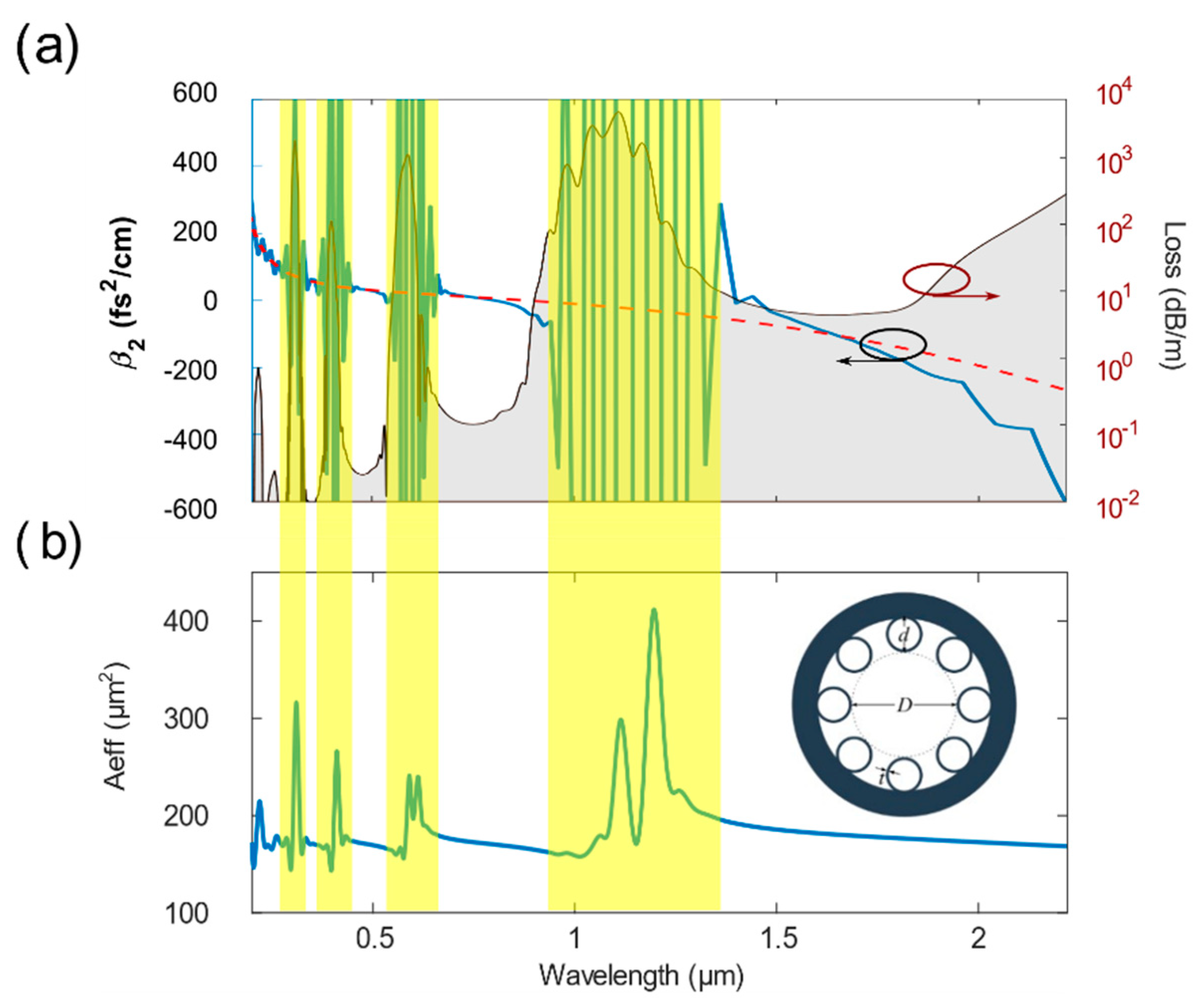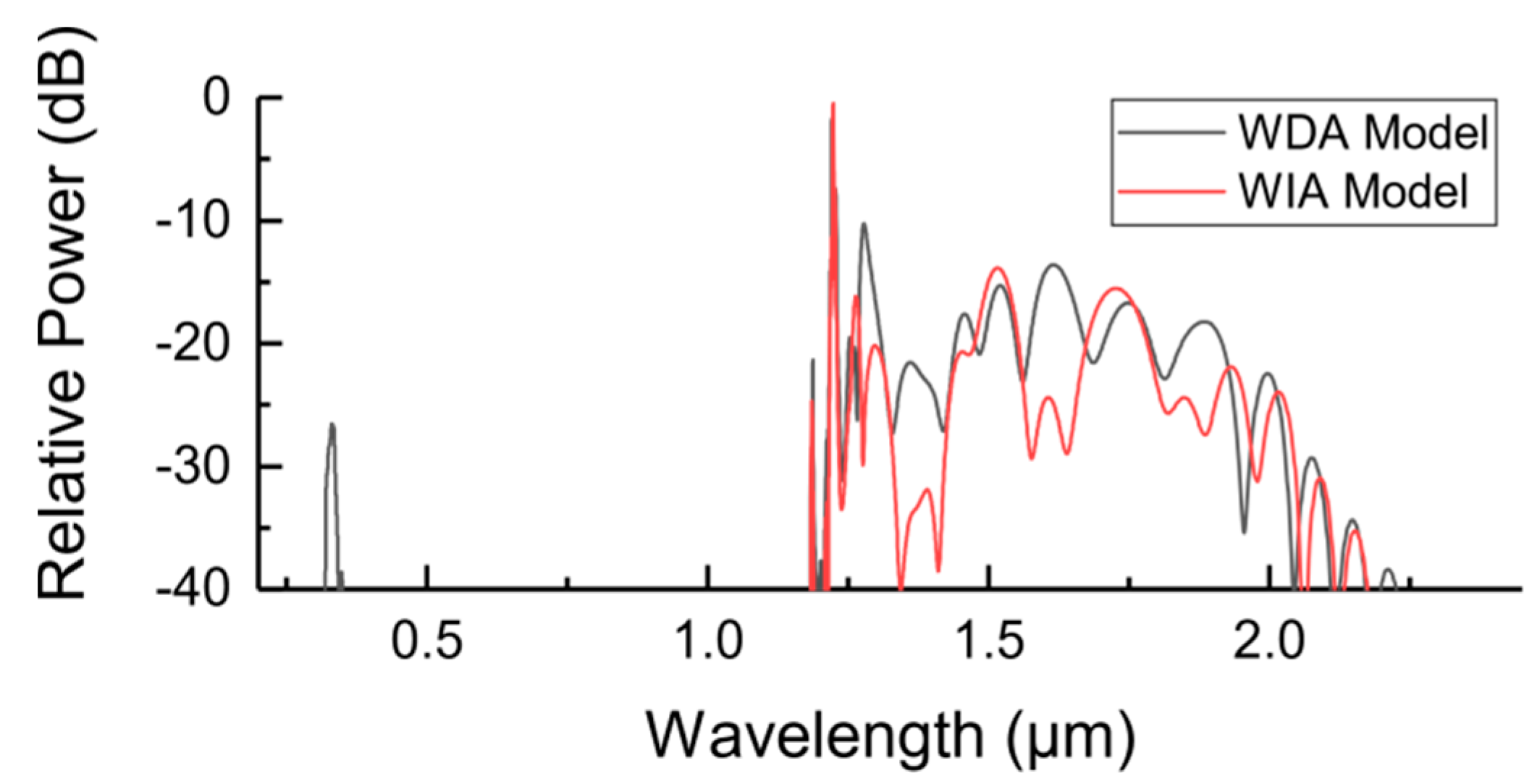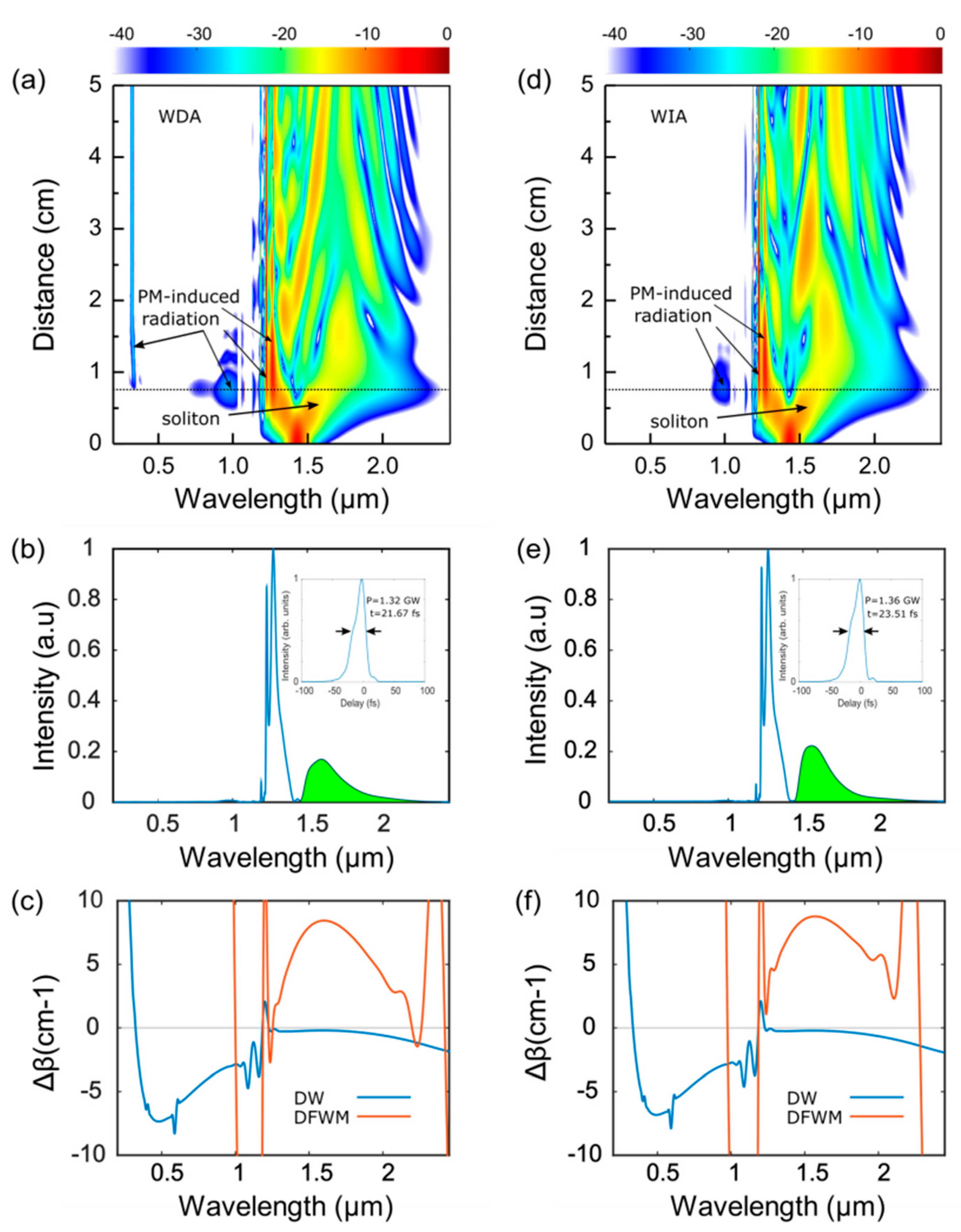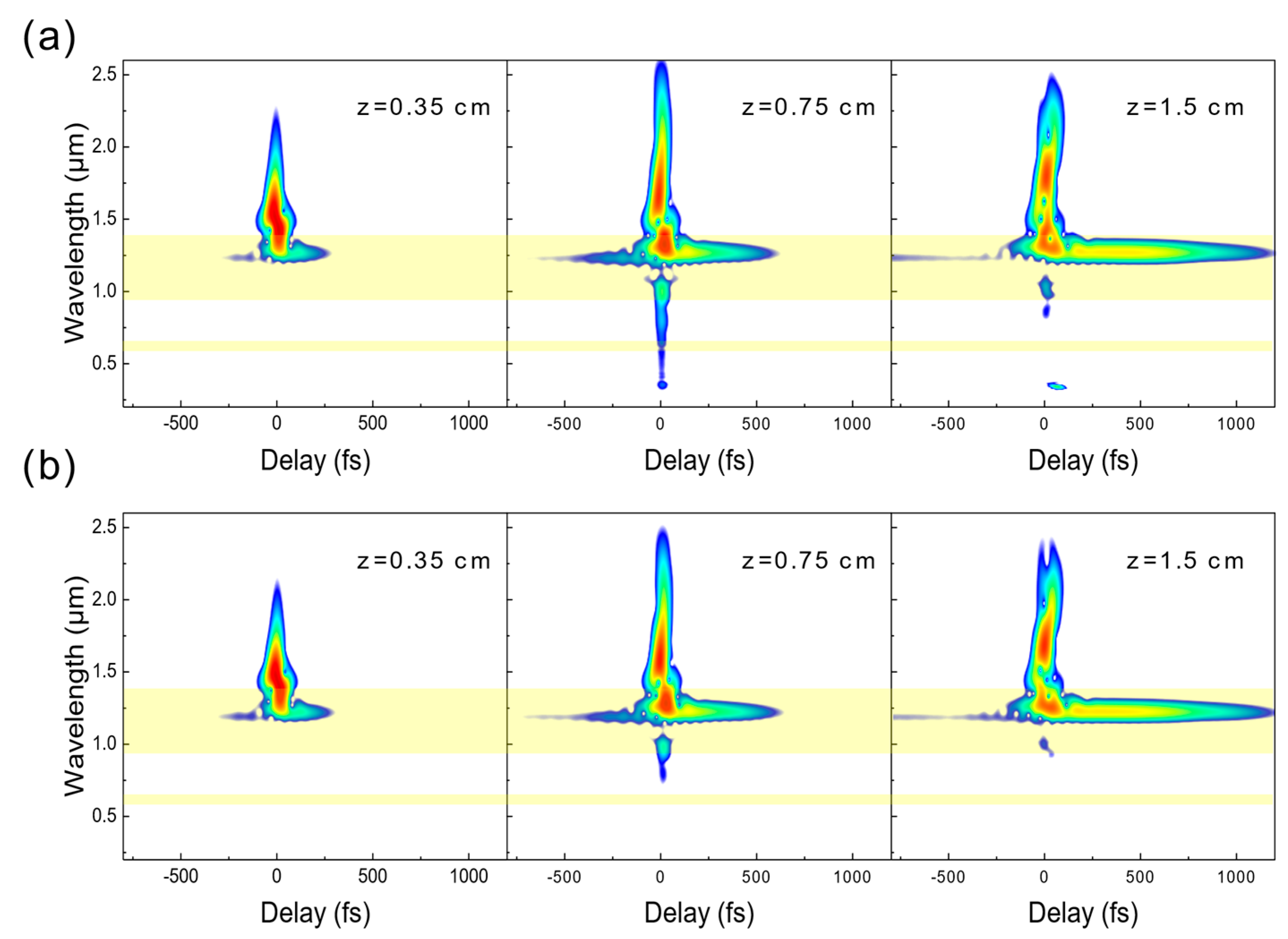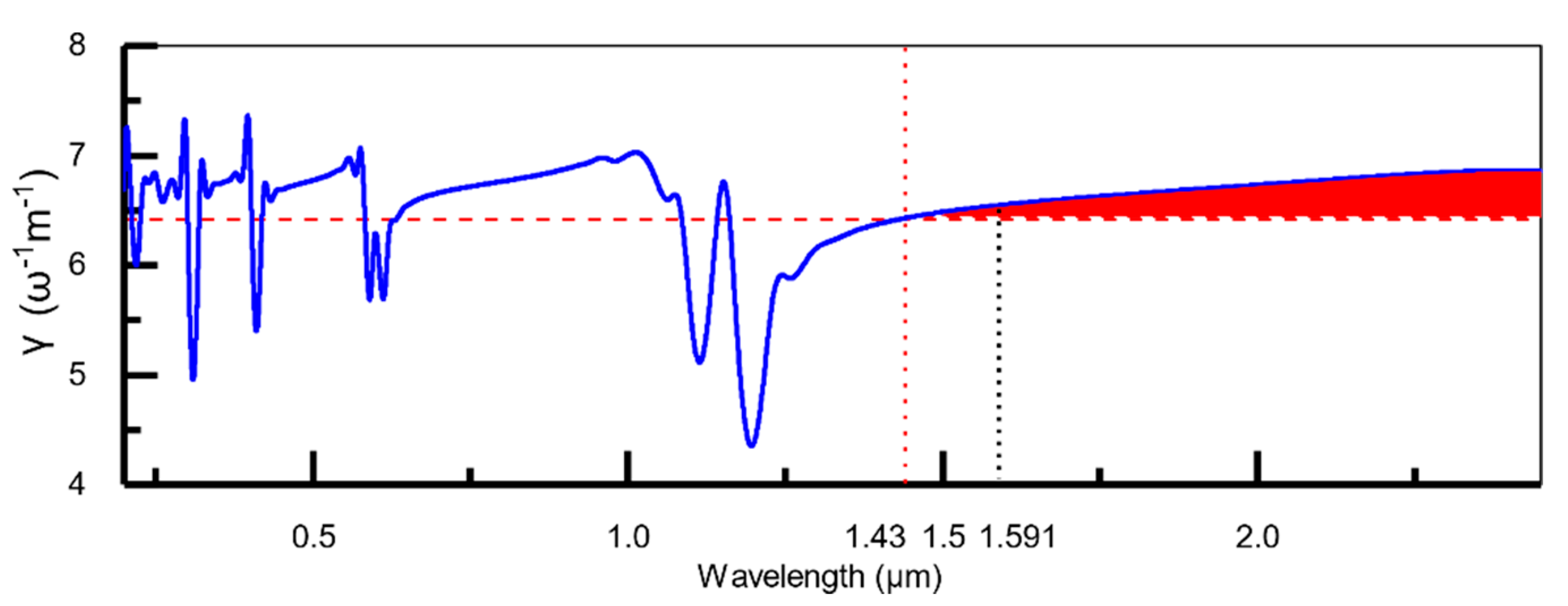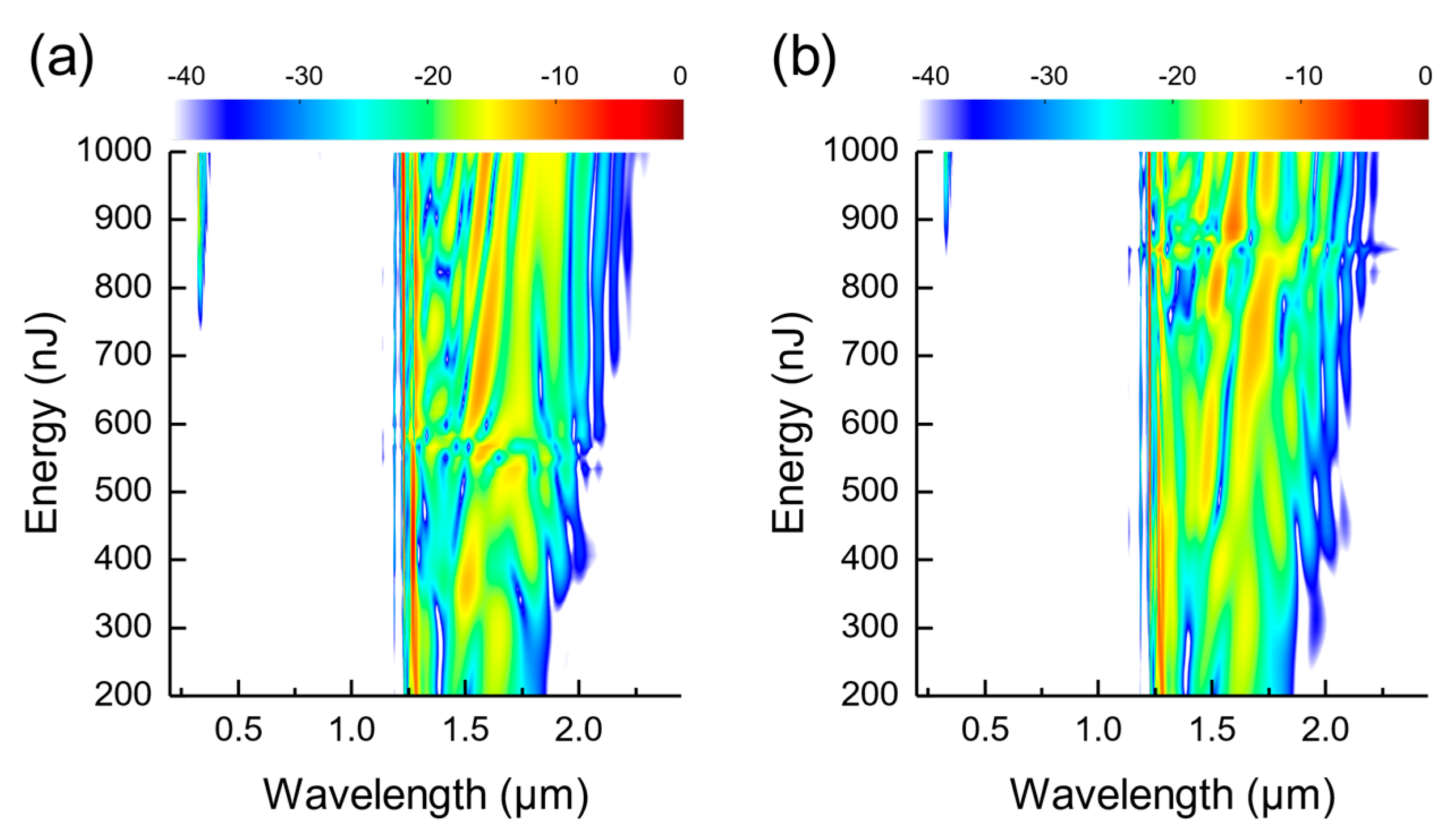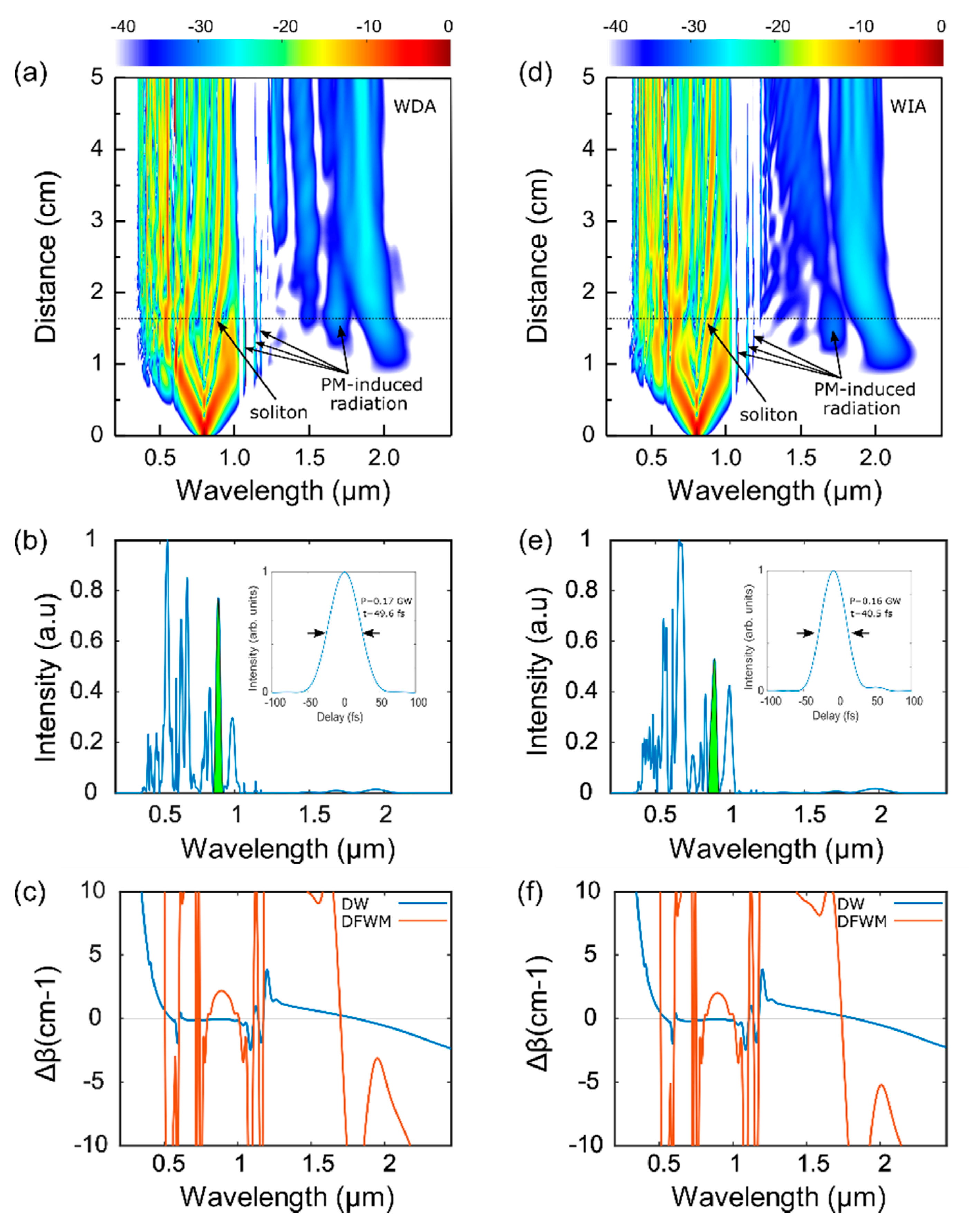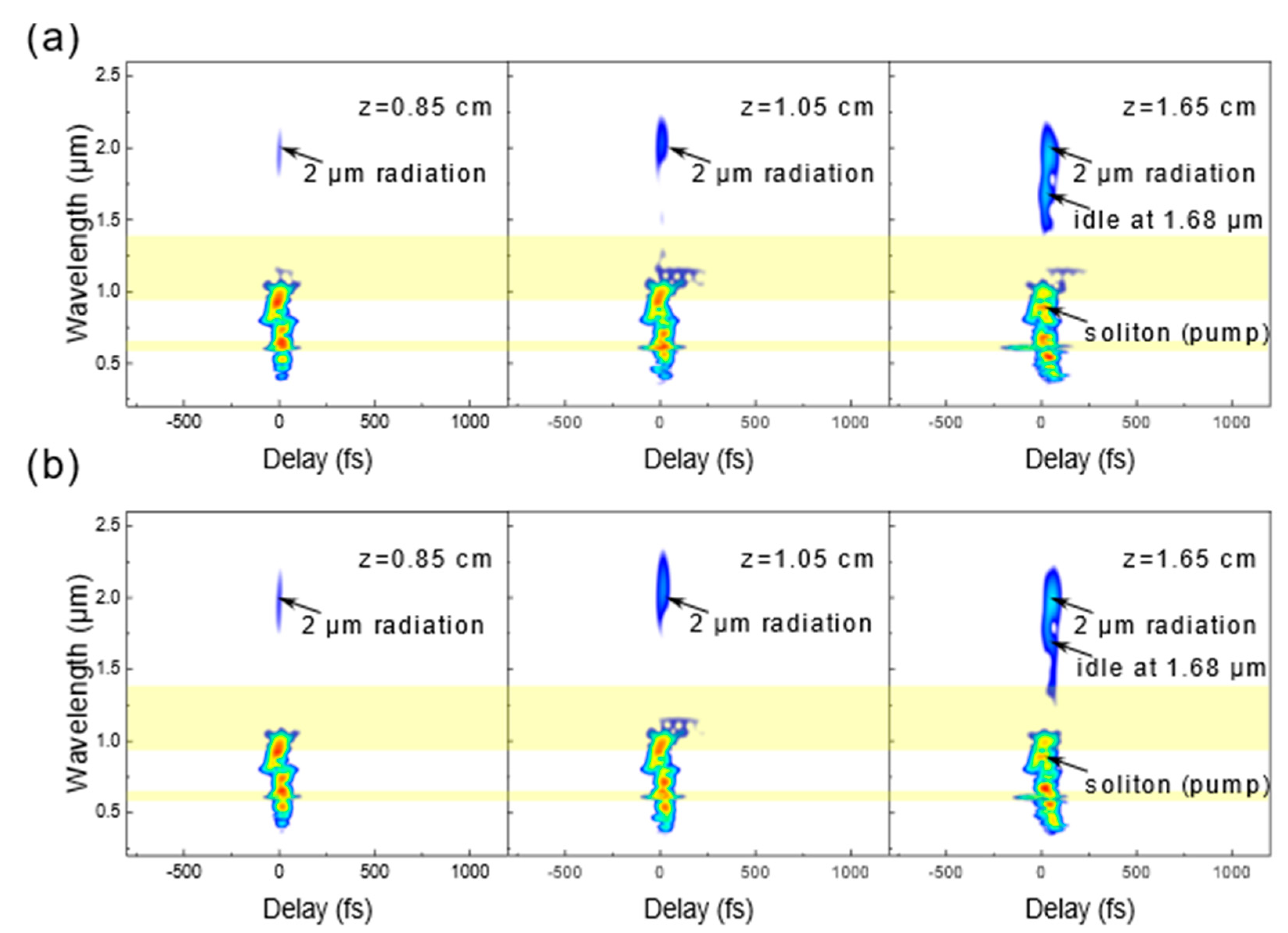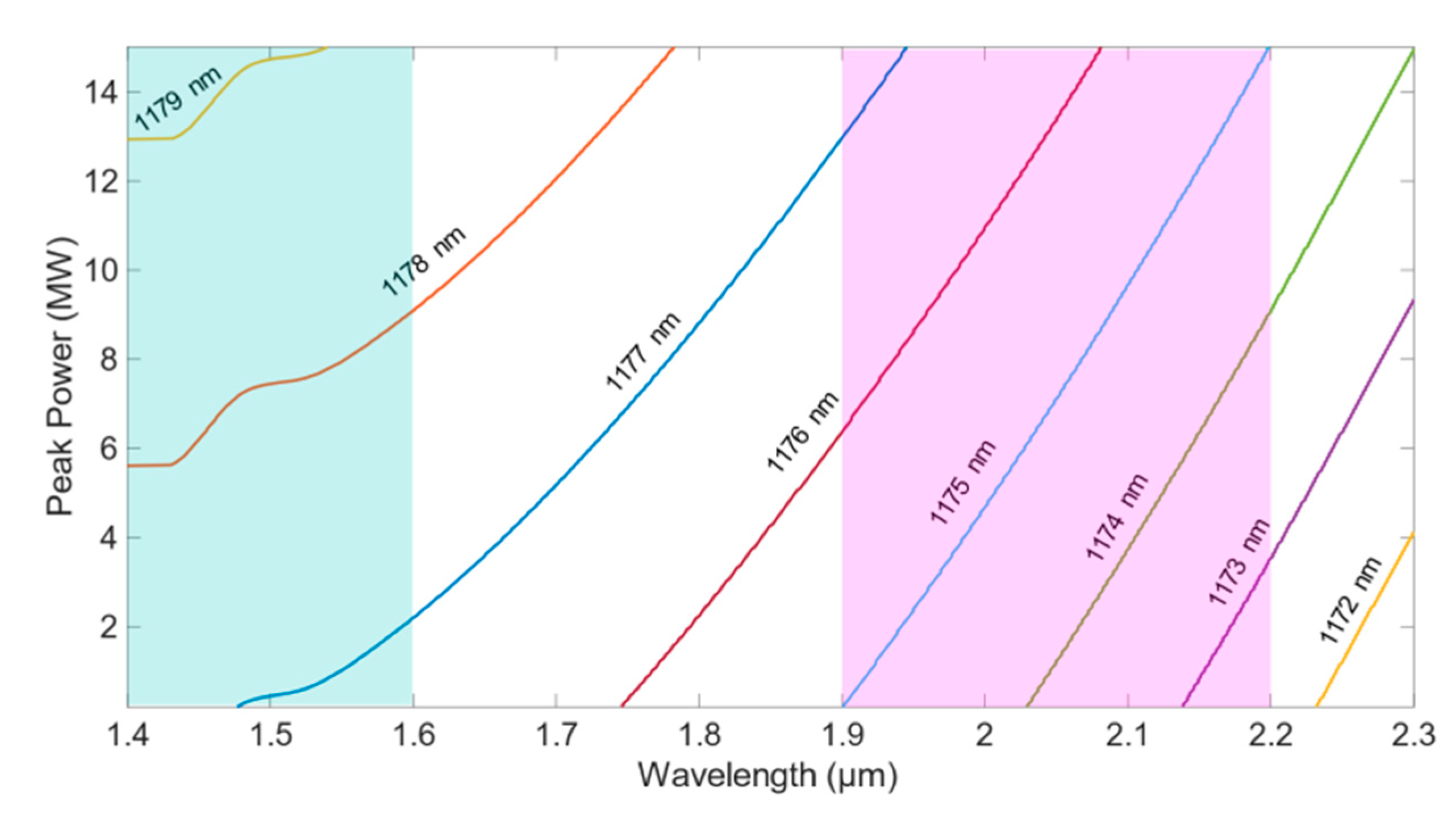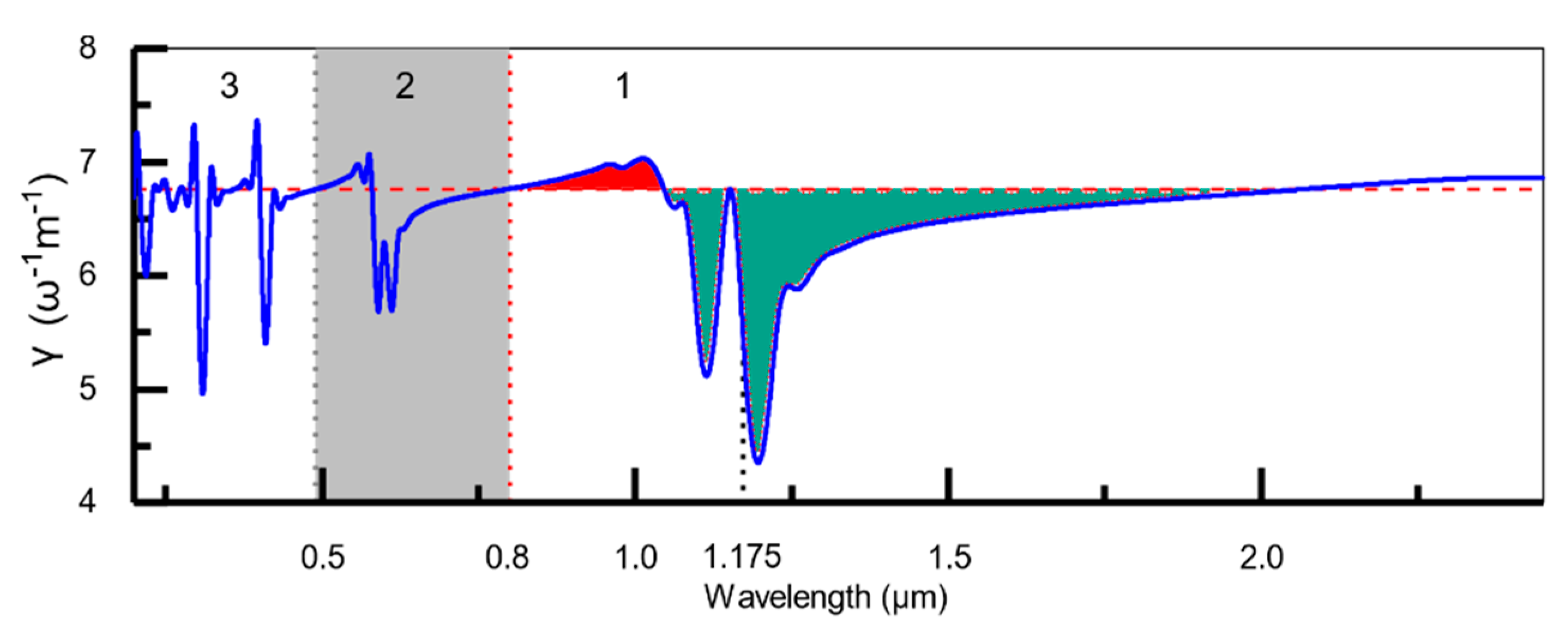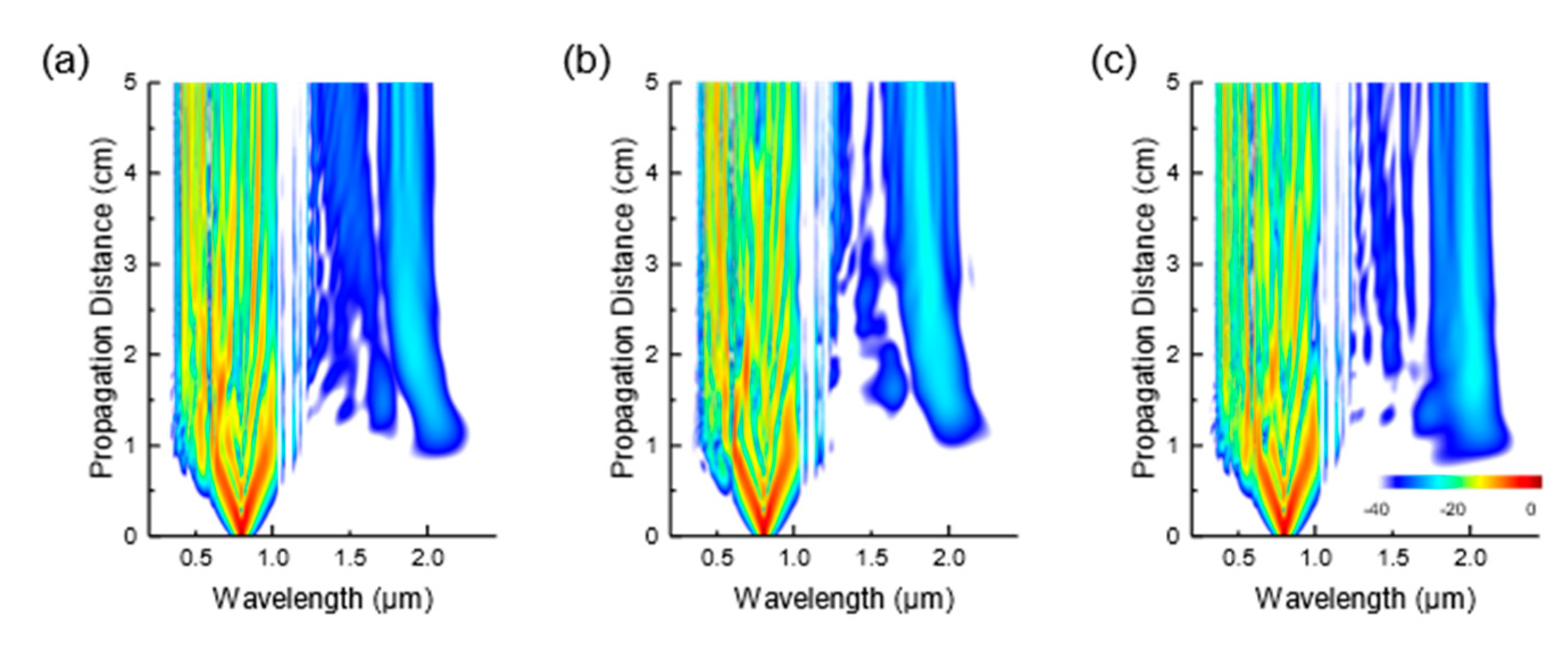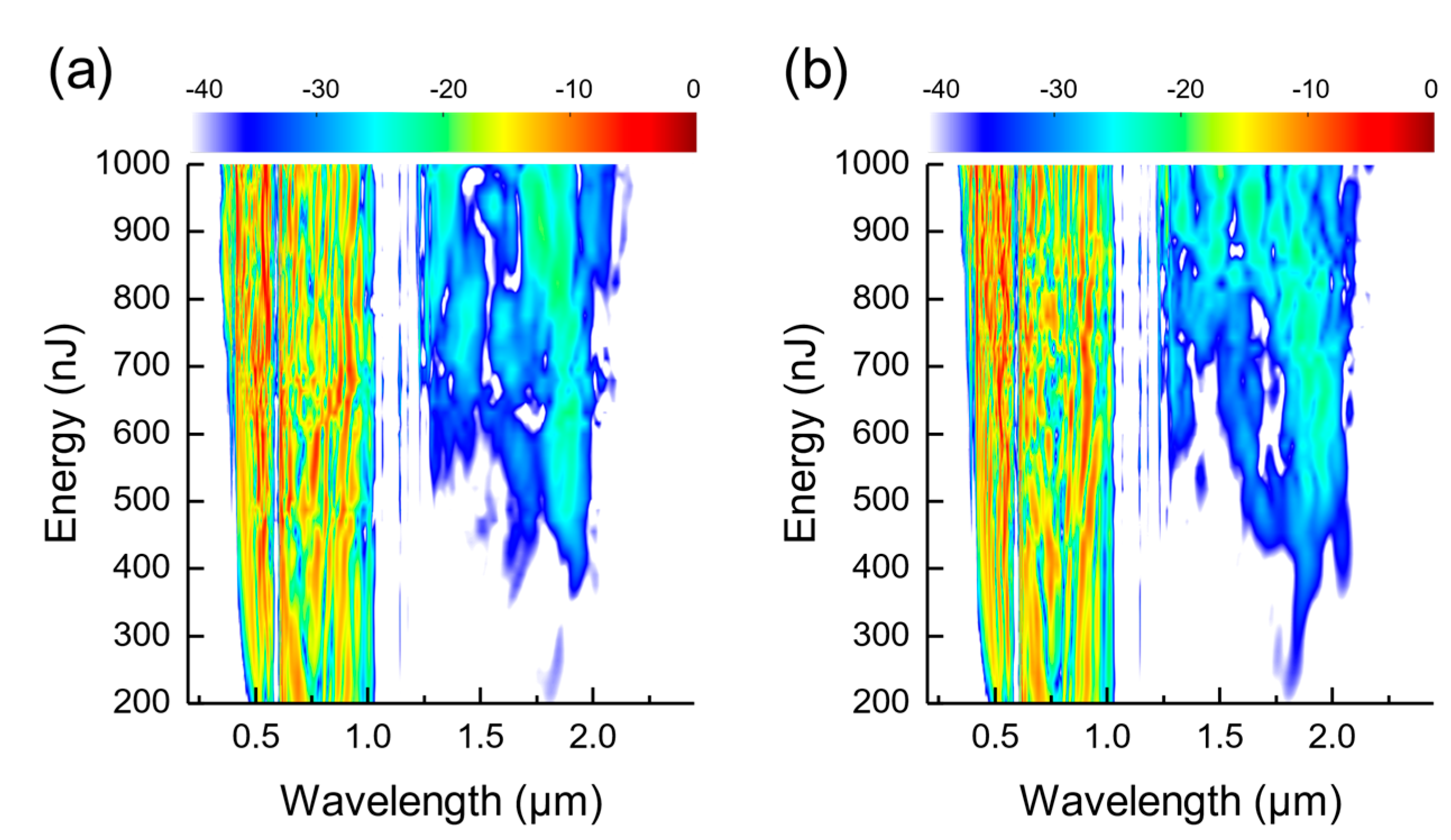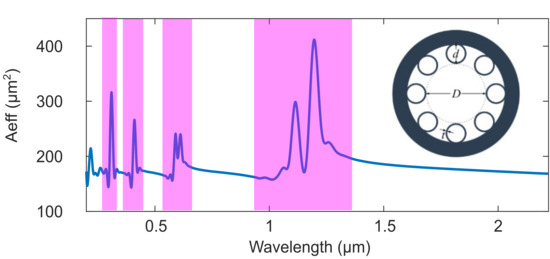3.1. Pulse Propagation at 1430 nm
We first investigate the case where the femtosecond pump is at 1430 nm wavelength as an example, which is close to the first resonant band and within the first transmission window. We launch a 30 fs, 0.8 µJ pulse centered at 1430 nm into a 5 cm-long AR-HCF filled with 20 bar xenon. We simulate the pulse propagation using two different models. One accounts for the wavelength-dependent mode area (WDA model) as outlined in Equations (1–4), and the other one assumes a constant mode area for all wavelengths, i.e., wavelength-independent mode area model (WIA model). The spectra obtained with the two models at the output of the fiber are shown in
Figure 2. They are normalized with respect to the maximum peak power obtained with the WDA model. We note that the spectral output of the WDA model is flatter, and it exhibits a spectral peak at 330 nm generated via dispersive wave emission. This is absent in the WIA model.
To identify the origin of the differences in the two cases, we compare the spectral evolutions under the two models shown in
Figure 3a,d. In both models, the pump at 1430 nm initially experiences weak normal dispersion. Due to strong nonlinearity coming from the high-density xenon, it undergoes rapid spectral broadening induced by self-phase modulation in both models, and a large chunk of the spectrum tunnels into the anomalous dispersion regime located above 1450 nm. The presence of the first resonant band near the pump prevents the broadening of the spectrum towards the shorter wavelength side. A similar phenomenon has also been observed in Ref. [
14], where the authors referred to it as a frequency locking effect. The strong effect of third-order dispersion near the resonance decelerates further frequency shift. As a result, the spectrum broadens asymmetrically towards the longer wavelength and the spectral component in the anomalous dispersion regime forms a soliton. In both cases, the maximum spectral broadening is achieved at around 0.75 cm, where the pulse is compressed to its shortest duration. After reaching the maximum compression, soliton fission accompanied by emission of a dispersive wave (DW) at 330 nm is observed in the WDA model, which arises due to the phase-matching between the soliton and linear wave in the presence of higher-order dispersion [
21]. The broadened pump spectrum overlaps with the phase-matching point initiating the onset of DW [
22,
23,
24]. Nevertheless, as shown in
Figure 3d, this is absent in the case of the WIA model. Since the DW generation is mediated by the soliton, we extract the green highlighted spectral components in
Figure 3b,e. We note that the two highlighted spectral components are both in the anomalous dispersion regime. However, they are centered at different wavelengths. In the WDA model, the center wavelength—wavelength with the highest intensity—is at 1591 nm, while in the WIA model, this is at 1559 nm. The temporal profiles of the green highlighted spectra are presented in the respective insets. Namely, the peak power is 1.32 GW and the full width at half maximum (FWHM) duration is 21.7 fs in the WDA model, corresponding to the soliton number,
. In the WIA model, the peak power is slightly higher at 1.36 GW and FWHM duration is longer at 23.5 fs, amounting to the soliton number,
.
Figure 3c,f shows the DW and degenerate four-wave mixing (DFWM) dephasings for the two solitons using their respective center wavelengths of the green-highlighted spectral band as the pump. The DW and DFWM phase-matching conditions are given by [
25]:
In Equation (5),
is the center angular frequency of the soliton and
is the peak power at its maximum compression point. In Equation (6),
,
, and
are the angular frequencies of the pump, idler, and signal in the DFWM process, and we use
in plotting
Figure 3e,f.
is the peak power of the pump soliton as indicated in the insets of
Figure 3b,e.
In
Figure 3c, the DW emission at 330 nm for the WDA model is accurately predicted. Some other phase-matching points, such as those located at 1.06 µm, 1.18 µm, and 1.23 µm in the dephasing plot are also manifested by radiations that appear at these wavelengths in
Figure 3a. Radiation induced by the rest of the phase-matching points is either too weak to be observed or being overlapped by the main pulse spectral. Observations are similar in the WIA model shown in
Figure 3d,e. However, we note that the phase-matching at around 330 nm is not reflected in the spectral evolution shown in
Figure 3d. We attribute this to weaker spectral overlap between the soliton and DW phase-matching point as shown in the subsequent analysis. The differences between the dephasings in both models are small, which is because the inclusion of the mode-area dispersion only slightly affects the nonlinear correction term, which has only a small contribution to the dephasing in both DW emission and DFWM process.
Figure 4a,b presents the spectrograms at different positions in AR-HCF with the WDA and WIA models. They are obtained using the cross-correlation frequency-resolved optical gating with a 35 fs Gaussian pulse as the gate. The pulse initially undergoes SPM-induced symmetric spectral broadening. After propagating for a short distance, the blue edge of the spectrum enters the highly dispersive resonant region, where the pulse experiences rapid temporal broadening and a decrease in the peak intensity. Moreover, the loss and mode area also increase substantially in the resonant band. The combination of these effects prohibits the spectrum’s further extension toward the shorter wavelength, making it highly asymmetric.
At 0.75 cm, the pulse reaches the maximum compression point, as indicated by the black dashed lines in
Figure 3a,d. In the case of the WDA model, the spectrum broadens significantly and overcomes the high-loss in the resonant region (highlighted in yellow in
Figure 4) and seeding sufficient photons at the DW phase-matching point at 330 nm. In the case of the WIA model, the spectral broadening is weaker, and its tail does not reach the phase-matching point in the ultraviolet region as shown in
Figure 4b middle panel, thus no emission is observed at 330 nm. A bigger spectral broadening is achieved in the WDA model than in the WIA model despite the lower soliton number.
The reason for the shorter compressed duration and stronger spectral broadening in the WDA model despite the smaller soliton number is due to the wavelength-dependent nonlinear coefficient,
.
Figure 5 shows
in the spectral region of our interest, and this is what is used in the pulse propagation simulation in the WDA model. The vertical red-dotted line marks the pump at 1430 nm, and the horizontal red-dashed line indicates the nonlinear coefficient at the pump wavelength, which is the value that is used in the WIA model. The soliton appears centered in the red shaded area, and hence the nonlinear coefficient experienced by the soliton in the WIA model is underestimated. The higher nonlinear parameter shifts the soliton in the WDA model further to the longer wavelength (center wavelength of 1591 nm at 0.75 cm) than the WIA model (center wavelength of 1559 nm at 0.75 cm) due to larger nonlinear phase shift induced by the stronger nonlinearity. As seen from the GVD profile in
Figure 1a, further away from the zero-dispersion wavelength at 1450 nm alleviates the impact of higher-order dispersion which deteriorates the soliton effect compression [
26], resulting in a shorter compressed duration for the soliton in the WDA model that supports a wider spectral broadening, as shown in the second column in
Figure 4a,b. Moreover, a higher nonlinear coefficient also enables more efficient energy transfer via the DFWM process [
27] to the intermediate wavelength at 1.06 µm in the WDA model, as evident in
Figure 3a,d.
Figure 6a,b shows the color density plot of the spectrum at the output of the 5 cm-long AR-HCF for varying pump pulse energies in the WDA and WIA models, respectively. The two results are indistinguishable at low energy levels (below 350 nJ), indicating that the effect of mode-area dispersion is small in this regime. As the pump energy increases, notable differences appear, implying growing importance of the mode-area dispersion. We also notice the threshold pump energy required for the onset of DW in the WIA model is higher (850 nJ) than the WDA model (740 nJ).
3.2. Pulse Propagation at 800 nm
We carry out another study with the pump now at 800 nm to observe the effect of mode-area dispersion when the system is pumped in the second transmission window. The other system parameters are kept the same as before.
Figure 7 shows the spectral outputs obtained with the two models. Enhanced emissions at around 1300, 1430, 1620, and 1840 nm are observed in the WDA model.
Unlike in the previous case where there is a broad spectral region of anomalous dispersion close to the pump that can facilitate the formation of solitons, the pump is bounded by resonant bands on both sides at 630 and 900 nm. Soliton can be formed in the spectral region between 800 and 900 nm, i.e., within the anomalous dispersion regime of the second transmission window. Outside this range, the dispersion and loss become very high, severely perturbing the pulse and suppressing the spectral advance into these regions.
Figure 8a,d shows the color density plots of the spectral evolutions of the 800 nm pump in the two models. A soliton appears in both the WDA and WIA models with different central wavelengths of 889 and 895 nm, respectively at
z = 1.65 cm, as indicated in
Figure 8a,d.
Figure 8b,e shows the spectra at
z = 1.65 cm for the two models. The part of the spectrum that forms the soliton is highlighted in green. In the time domain, this part translates to a pulse with the peak power of 170 MW and FWHM duration of 49.6 fs amounting to a higher-order soliton with
N = 4.64 in the case of the WDA model, and peak power of 160 MW and FWHM duration of 40.5 fs amounting to
N = 3.54 soliton in the WIA model.
Figure 8c,f shows the DW and DFWM dephasing induced by the soliton highlighted in
Figure 8b,e as the pump. Multiple DW and DFWM phase-matching wavelengths are achieved in both models. Some of them can be identified in the spectral evolutions in
Figure 8a,d, such as the discrete narrow radiation bands in the first resonant region as well as the radiation at 1.68 µm, as indicated by the arrows. Their spectral locations match well with those predicted in the dephasing plots in
Figure 8c,f. Other radiations such as the band at around 2 µm are induced through four-wave mixing as we shall see later.
We plot the spectrogram evolutions for the two cases using the same approach as in
Figure 4. These are presented in
Figure 9. In both the WDA and WIA models, the pulse initially experiences self-phase modulation induced spectral broadening. At z = 0.85 cm, the red-edge of the spectrum reaches the wavelength of around 1.17 µm, which is in the first resonant band (wide yellow area), while the blue edge of spectrum continues to move to the shorter wavelength, passing through the second resonant band (narrow yellow area), and eventually appears in the third transmission window. At the same time, weak radiation emerges at 2 µm in both cases.
At
z = 1.05 cm, the red edge of the spectrum is pushed further into the first resonant band and more energy is transferred to the 1.9–2.2 µm region. As it will be shown in the subsequent section, this radiation is caused by a four-wave mixing process induced by the pump photons in the first resonant band at around 1.17 μm. At
z = 1.65 cm, the soliton indicated by the arrows in the last column in
Figure 9 generates a new wavelength component centered at 1.68 µm through the DFWM process. The newly generated band at 1.68 µm overlaps with the pump soliton in the time domain in both models, as shown in the last columns in
Figure 9a,b. Similarly, the 2 µm radiation also overlaps temporally with the pump located in the first resonant band in both models.
Due to the complex evolutionary dynamics in the presence of severe perturbation by resonant bands, the phase-matching conditions for the multiple radiation bands in the first transmission window, such as the 2 µm radiation, cannot be explicitly determined. We verify our previous assumption that these radiations are generated via DFWM processes from the pump photons in the wavelength range between 1170 and 1180 nm. We estimate the actual peak power of the soliton to be within 0.2 to 15 MW. Based on the relation given in Equation (6), we calculate the phase-matching points by scanning through different values of pump photon wavelengths and soliton peak powers within these specified ranges. Since there may be multiple phase-matching wavelengths due to the rapid variation in the dispersion near the resonances, we select only the phase-matching point with the longest wavelength. The results are plotted in
Figure 10.
As we can see in
Figure 10, the phase-matching wavelength increases with decreasing pump photon wavelength and increasing peak power
. Since the pump is in the first resonant band where the dispersion varies rapidly, even a small difference in its wavelength results in a large shift in the phase-matching wavelength. As the pump moves to the longer wavelength, deeper into the first resonant band, the phase-matching wavelength changes more rapidly. The radiation located in the spectral region between 1.9 µm and 2.2 µm is highlighted in pink. Therefore, we can conclude; the pump that is responsible for the generation of the abovementioned DFWM-induced radiation bands is located between 1173 and 1177 nm, confirming our earlier assertion that the radiation at around 2 µm is generated via DFWM with the pump at around 1.17 µm. We verify that no other pump wavelengths can achieve the radiation at 2 µm via DFWM. We also observe some weaker radiations in the spectral region between 1.4 and 1.6 µm in both models as shown in
Figure 8a,d. This is highlighted in cyan in
Figure 10. Similarly, we can conclude that these radiations are also caused by DFWM, with the pump photon slightly longer at around 1177 to 1179 nm. As the pulse propagates, its spectrum continues to broaden towards the red side, expanding deeper into the first resonant band at around 1177 to 1179 nm and seed series of DFWM-induced phase matching radiations ranges between 1.4 and 1.6 µm. As the wavelength of the pump photon increases, the phase-matching wavelength shifts to a shorter wavelength. However, due to exponentially increasing loss and substantially reduced nonlinearity around the resonance, further spectral broadening into the longer wavelength is largely impeded and DFWM-induced conversion becomes inefficient. This also explains why the 2 µm radiation band appears earlier and the radiation bands with shorter wavelengths emerge later in the propagation with weaker intensities.
By comparing
Figure 9a,b, we observe that the 2 µm radiation at
z = 1.05 cm in the WDA model is weaker than that in the WIA model. On the contrary, the 1.68 µm radiation that appears at
z = 1.65 cm in the WDA model is stronger than that in the WIA model. This is also shown in
Figure 8a,d. We investigate the reason for the difference by looking at the nonlinear coefficient across the spectrum in
Figure 11. Note that this is the same plot as shown in
Figure 5, but with the constant nonlinear coefficient used in the WIA model evaluated at the new pump wavelength of 800 nm.
To facilitate our analysis, we separate the nonlinear coefficient profile into three sections as indicated in
Figure 11. Each of the first two resonant bands sits in
Section 1 and
Section 2, respectively. The third and fourth resonant bands are in
Section 3. In
Section 1, the red (green) shaded area indicates the region where the nonlinear coefficient in the WDA model is higher (lower) than that in the WIA model. The solitons highlighted in
Figure 8b,e are located in the red shaded region while the DFWM pump photons at around 1175 nm are in the green shaded region. Since the nonlinear coefficient at 1175 nm in the WDA model is below that of the WIA model as shown in
Figure 11, there is a less efficient conversion of the pump to the signal and idler in the DFWM process, resulting in weaker radiation at 2 µm compared to that in the WIA model. This is evident from the spectrograms in the middle column of
Figure 9a,b. The nonlinear coefficient at 889 nm, which the soliton is centered at in the WDA model, is higher than that perceived by the soliton in the WIA model. Hence, a larger amount of energy is transferred to the 1.68 µm band in the WDA model by the soliton through a more efficient DFWM process, as seen in the last column of
Figure 9a,b.
Figure 12a–c shows the simulation results when the mode-area dispersion is assumed only in either
Section 1,
Section 2, or
Section 3, respectively while keeping the coefficient constant with the value evaluated at 800 nm in the other Sections. This is to separately study the impact of mode-area dispersion for different resonant bands. We find that when we consider the mode-area dispersion only in
Section 1, the spectral evolution is almost identical to that of the WIA model as shown in
Figure 8a,d. From this, we can conclude that the mode-area dispersion in the third and fourth resonant bands has a negligible effect on the pulse propagation dynamics. This is because they are far from the pump wavelength at 800 nm and, therefore, have a negligible effect on the main pulse. The inclusion of the mode-area dispersion around the first or second resonant bands affects the pulse propagation dynamics in the first transmission window (above 1400 nm) and second transmission window (550–900 nm), as can be seen from the comparison between
Figure 12a–c. Some of the notable differences lie in the first transmission window. While all three cases show relatively strong radiation at around 2 µm, other radiations in the wavelength between 1.3 to 1.6 µm are totally different. We attribute these differences to the change in DFWM phase-matching conditions and conversion efficiency when using different nonlinear coefficient profiles.
Figure 13a,b shows the output spectra of the 800 nm pump after propagating the 5-cm long xenon-filled AR-HCF with different pump energies for the WDA and WIA models, respectively. Similar to the case of pumping at 1430 nm, the differences between the WDA and WIA models are small at low energy levels (below 400 nJ). As the energy increases, the differences become more pronounced. The radiations in the first transmission window mediated by the DFWM process are completely different between the WDA and WIA models at all energy levels, indicating that the process is highly sensitive to the mode-area dispersion. This is expected since the spectral components in the first transmission window are induced by the pump photons in the vicinity of the first resonant band, where the mode-area undergoes a dramatic change in the WDA model.
